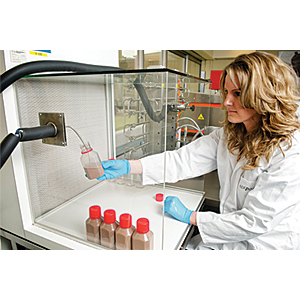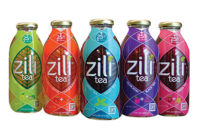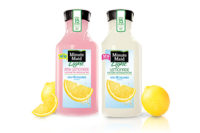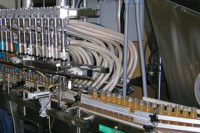Once considered a food of the gods by Aztec and Mayan cultures, chocolate today is an affordable indulgence with some health benefits that has retained its popularity even during rough economic times. According to Santa Monica, Calif.-based IBISWorld, total chocolate industry revenue increased 2.5 percent this year to more than $15.5 billion, and the market research firm expects consumer demand to continue to grow during the next five years.

|
| ADM Cocoa International works with new deZaan Chocolate Microflakes to make a yogurt drink in the lab. DeZaan Chocolate Microflakes combine the rich flavor and color of chocolate with the easy-to-use properties of cocoa powder, the company says. |
Consumers across all demographic groups enjoy chocolate, says Leanne de Muijnck, technical services and product development for ADM Cocoa, a company of Archer Daniels Midland Co., Decatur, Ill. “Both the smooth mouthfeel and flavor sensation [of chocolate] generate an experience consumers seldom get tired of,” she says.
Respondents to Beverage Industry’s 2012 New Product Development Survey affirm chocolate’s general popularity, naming it the No. 2 anticipated best-selling flavor of 2012.
Chocolate appears in a variety of drinks in the marketplace, from milk, hot cocoa and drinking chocolate to nutritional beverages and even alcohol beverages, says Courtney LeDrew, marketing manager for Cargill Inc., Minneapolis.
According to Mintel’s Global New Products Database, 145 new beverages containing chocolate have hit the market since November 2011. Among these new chocolate drinks is the Indulgent Collection of hot chocolates by Swiss Miss, a brand of Naperville, Ill.-based ConAgra Foods Inc. Launched in September, the new collection offers premium hot chocolate mixes in French Vanilla, Caramel, Mint, Chocolate Truffle and Dark Chocolate varieties.
Chocolate is most popular in the dairy drinks category, including hot chocolate, because the chocolate and dairy flavors complement each other well, says Stacy Reed, technical services representative at Cargill. “Milk products often undergo heat processing, which, much like cocoa and chocolate, can aid in flavor developments through Maillard reaction byproducts such as furanones, pyranones and pyrazines. These compounds contribute complementary flavor notes such as roasted, caramel, sweet, fruity, buttery, nutty and ‘ghee’ that offer expanded, richer flavor bouquets to finished products.”
Lately, chocolate has become more popular in nutritional beverages as well because it increases the attractiveness of the drinks and masks some of the flavor notes associated with high protein content, adds ADM’s Muijnck.
Companies also add chocolate or cocoa to a drink to give it an attractive brown or reddish shade, ADM’s Muijnck says. Color is an important factor to consumers and food and beverage manufacturers because color is one of the first messages the brain receives in making a sensory judgment on a consumer product, according to ADM Advantage Cocoa University’s website. Because of chocolate’s widespread popularity, most consumers associate these brown and reddish shades with chocolate and its general appeal, with lighter shades mentally related to lighter chocolate flavors and darker shades linked to darker chocolate tastes, it states.
The most common ingredient for chocolate drinks is cocoa. Drinks most often feature a 10 to 12 percent fat cocoa content, but trends toward using chocolate as an indulgence require higher-fat cocoas, which provide a creamier mouthfeel, ADM’s Muijnck says.
In most cases, beverage-makers opt for cocoa powder because it is easier to incorporate and provides more concentrated flavor, says Kim Yoder, technical service manager for Cargill.
Cargill offers Gerkens cocoa powder, which is available in a range of flavor, color and fat content profiles, according to its website. The company also offers some organic and single-origin powders, it says. “We produce cocoa powders with a high degree of fineness that provides the benefit of the full release of color and flavor,” the company says. The degree of fineness also helps control sedimentation in ready-to-drink beverages, it notes. Several of Cargill’s powders also can be lecithinated for improved wettability properties, it adds.
Instead of cocoa powder, chocolate also can be used, but it is more difficult to handle, adds Katy Cole, technical service manager for Cargill. “It needs to be melted before it can be incorporated into a beverage application,” she says. “Ground forms of chocolate can be an advantage in these situations because the smaller surface area allows the chocolate to melt faster.”
To meld the convenience of cocoa powder with the indulgent properties of real chocolate, ADM introduced this year deZaan Chocolate Microflakes, which offer chocolate’s rich flavor and color in an easy-to-disperse and easy-to-dissolve powder form that does not require pre-melting, the company says. Plus, the microflakes offer at least 15 percent less fat than regular chocolate, it adds.
“Until now, established practice has been to use both cocoa powder and chocolate, but this has proven unsatisfactory, as neither product alone gives the optimal impact,” said Simon Godden, new product development manager at ADM Cocoa International, in a statement. “With our specialized technical knowledge of the properties of both cocoa powder and chocolate, we were able to draw out the best qualities of each and bring them together into one innovative solution.” BI





